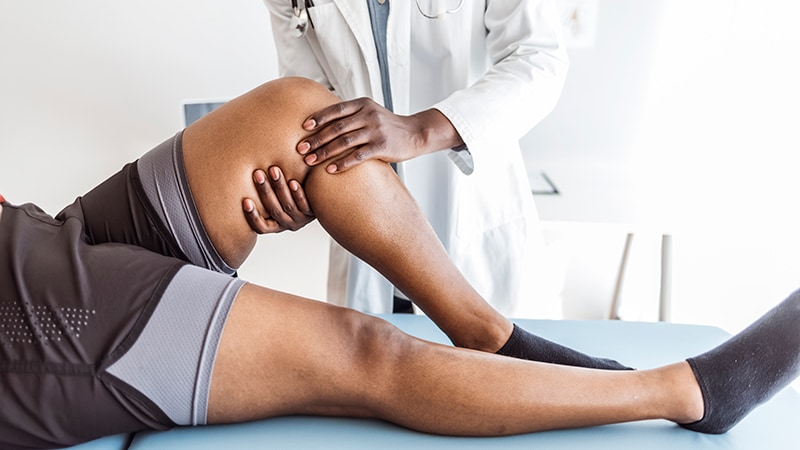insight - Medical Imaging - # Point-of-Care Ultrasound for Diagnosing Knee Meniscal Injuries in Primary Care
Ultrasound Enables Primary Care Clinicians to Accurately Diagnose Knee Meniscal Injuries
Core Concepts
Point-of-care ultrasound (POCUS) can enable primary care clinicians to reliably diagnose meniscal injuries, reducing the need for advanced imaging and specialty consultations, particularly in resource-limited settings.
Abstract
This article discusses a study that explored the use of point-of-care ultrasound (POCUS) by primary care clinicians to diagnose meniscal injuries in patients with acute knee injuries. Patients with such injuries often face delays in obtaining advanced imaging like MRI, especially in safety-net hospitals and other resource-limited settings.
The researchers from New York City Health and Hospitals/Bellevue implemented POCUS into the diagnostic process at their safety-net hospital. Primary care and urgent care clinicians were trained to use POCUS and place markers on ultrasound images to denote areas of concern, which were then reviewed by outside clinicians.
The study found that in cases where meniscal injuries were suspected, the addition of POCUS to the standard history and physical examination provided reliable results. Out of the 11 patients identified with meniscal injuries using POCUS, 6 underwent MRI, confirming the diagnosis in all cases.
The findings highlight the effectiveness of POCUS in diagnosing meniscal injuries and suggest that wider application of this technology in clinical and urgent care settings can improve patient outcomes by expediting care and reducing the burden on more advanced imaging resources like MRI, particularly in resource-limited settings.
Ultrasound in Primary Care Detects Knee Injuries
Stats
Out of the 11 patients identified with meniscal injuries using POCUS, 6 underwent MRI, confirming the diagnosis in all cases.
Quotes
"This tool [POCUS] can significantly reduce the need for advanced imaging and specialty consultations, which is particularly beneficial in resource-limited settings."
"Wider application of POCUS in a clinical and urgent care setting can 'improve patient outcomes by expediting care and reducing the burden on more advanced imaging resources,' such as MRI."
Key Insights Distilled From
by Lara Salahi at www.medscape.com 05-31-2024
https://www.medscape.com/viewarticle/primary-care-physicians-can-successfully-diagnose-meniscal-2024a1000a7v
Deeper Inquiries
What are the potential limitations or challenges in implementing POCUS for knee injury diagnosis in primary care settings?
While point-of-care ultrasound (POCUS) shows promise in diagnosing knee injuries in primary care settings, there are several limitations and challenges to consider. One key limitation is the need for proper training and expertise among primary care clinicians to perform and interpret POCUS accurately. Without adequate training, there is a risk of misdiagnosis or overlooking important findings. Additionally, the availability of ultrasound equipment and the associated costs may pose challenges for some primary care practices, especially in resource-limited settings. Furthermore, the scope of POCUS is limited compared to advanced imaging modalities like MRI, which may result in missed diagnoses or the need for additional imaging studies in certain cases.
How can the accuracy and reliability of POCUS for diagnosing knee injuries be further improved and validated?
To enhance the accuracy and reliability of POCUS for diagnosing knee injuries, several strategies can be implemented. First and foremost, ongoing training and education programs should be provided to primary care clinicians to ensure proficiency in performing and interpreting knee POCUS. Standardized protocols and guidelines for conducting POCUS examinations can also help improve consistency and reliability across different healthcare settings. Collaborative efforts between primary care providers and radiologists or orthopedic specialists can facilitate the validation of POCUS findings through comparative analysis with advanced imaging studies like MRI. Additionally, conducting further research studies with larger sample sizes and diverse patient populations can help validate the effectiveness of POCUS in diagnosing knee injuries and identify areas for improvement.
What other types of musculoskeletal injuries or conditions could potentially benefit from the use of POCUS in primary care, and how could this technology be expanded to those areas?
Beyond knee injuries, several other musculoskeletal conditions could potentially benefit from the use of POCUS in primary care settings. Common conditions such as shoulder injuries (rotator cuff tears, tendonitis), ankle sprains, and wrist fractures are prime candidates for POCUS evaluation due to their prevalence in primary care practice. By expanding the training and utilization of POCUS to include these musculoskeletal areas, primary care clinicians can enhance their diagnostic capabilities and streamline patient care pathways. Moreover, exploring the use of POCUS in assessing soft tissue injuries, joint effusions, and musculoskeletal infections can further broaden the application of this technology in primary care. Collaborative efforts between different medical specialties, continued research, and advancements in ultrasound technology can facilitate the expansion of POCUS to various musculoskeletal injuries and conditions, ultimately improving patient outcomes and healthcare delivery.
0
More on Medical Imaging
